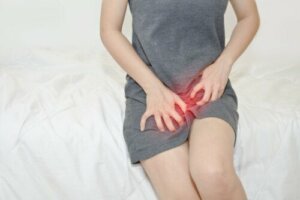Dyspareunia or Coitalgia: Causes and Treatments


Written and verified by the biologist Samuel Antonio Sánchez Amador
Dyspareunia, or coitalgia, is a condition that causes various unpleasant symptoms related to sexual intercourse, both in men and women. This disorder, in its least serious state, can involve slight genital irritation or even extreme pain before, during, or after intercourse.
Several medical studies indicate that this condition is much more common in women, but it can also occur in men, generally due to urethral infections or phimosis. If you want to find out more about the possible treatments and causes of dyspareunia, or coitalgia, read on.
Dyspareunia around the world
The sexual act is taboo in many social areas and cultures. Therefore, it’s important to note that coitalgia is much more common than you may think. The World Health Organization (WHO) and different epidemiological studies provide the following data regarding painful sexual intercourse:
- In women of reproductive age, dyspareunia occurs in between 10 and 15%.
- In the pre-menopausal stage, this condition becomes more common, affecting up to 30% of women.
- The average age of people suffering from this condition is 36.5 years.
- In men, there hasn’t been as much research, but the prevalence fluctuates between 0.1 and 5%.
As you can see, painful sexual relations are common in the general population, especially in women.
Not feeling pleasure while having sex is not the norm. So, seeing a doctor and/or professional because of this lack of enjoyment is completely legitimate and necessary.

Get to know more: What’s Sex After a Hysterectomy Like?
Dyspareunia: the causes
As we’ve already said, dyspareunia is the pain experienced in the genitals or pelvic area, associated with sexual practices. It can even occur up to 24 hours after sex. Some of the most common symptoms, reported by medical organizations, are the following:
- Pain when initial penetration takes place
- Pain at each point of penetration, or after introducing an external element in the vagina, such as a tampon
- A burning sensation and discomfort during sex
- An acute stabbing discomfort that can remain for several hours after intercourse
Most of the symptoms are associated with women’s experiences. In men, as we’ve already said, it’s much less common. Even so, when it does occur, it’s usually only at the time of ejaculation.
To address the causes of this condition, we need to divide it into two categories: physical and psychological. We’ll explain these both below.
Physical causes
The physical causes of dyspareunia are multiple and varied. For example, clinical studies have shown that this condition is very common after childbirth, like the tearing of the pelvic musculature, and the pressure that the vagina has been under will increase its sensitivity.
Although it may seem surprising, in nursing mothers, researchers have also observed that coitalgia is linked to decreased levels of estrogen in the blood. This happens because hormonal imbalances lead to dryness in the vagina.
Other physical causes of dyspareunia in women are the following:
- Infectious vaginitis: The most common cause is an infection caused by the fungus Candida albicans. This causes irritation and inflammation of the vaginal walls, which can make sexual intercourse difficult and painful.
- Insufficient lubrication: A lack of vaginal secretion due to hormonal changes, lack of desire or excitement, and other associated pathologies.
- Congenital abnormalities: An improperly formed vagina or imperfections in the hymen can be factors that make sexual intercourse difficult.
Again, we must reiterate that most of these cases have been studied in women. Other research states that dyspareunia, or male coitalgia, is often associated with an obstruction of the ejaculatory duct. Pathologies such as chronic prostatitis can produce pelvic discomfort in men.
Psychological causes
This condition doesn’t only have to do with the body. The research we’ve already mentioned estimates that more than 70% of the cases of dyspareunia don’t show any type of physical cause.
This highlights the large psychosexual component in this disorder. Some of the psychological parameters that can play an essential role are the following:
- Anxiety and depression: Self-esteem issues or a lack of trust with your partner can trigger the appearance of coitalgia.
- Stress: Continual stress causes tension in the pelvic muscles.
- Sexual abuse: Medical reviews highlight that, on some occasions, dyspareunia is linked to a history of violence and sexual abuse in the patient.

What treatment is available?
Thankfully, there are medical treatments available to treat dyspareunia or coitalgia. For example, if the pain is due to a fungal or bacterial infection, then the patient will need to apply antifungal or antibiotic medication. Doctors may prescribe topical estrogen to postmenopausal or lactating women to promote vaginal lubrication.
The causes are so varied that doctors must tailor treatment to each patient. A common help for all sufferers is couples therapy and some type of sex education.
As we’ve seen, dyspareunia is linked to the psychological side of the patient. In this sense, comfort, safety, and prior arousal are essential to avoid pain during sexual intercourse.
Wanting to feel pleasure is not a reason to feel embarrassment or vulnerability. We recommend talking to your partner as a first essential step to improving the situation.
You may be interested in: Testicular Torsion: Symptoms and Causes
Pain during sex: Some conclusions
Pain during sex is quite common, especially in women, where it can occur in 30% of the population at certain ages. Therefore, communication with your partner is vital. Changing sexual positions, using lubricants, and avoiding stress are always good options to avoid dyspareunia.
Even so, not all cases correspond to psychological problems. Coitalgia can be a sign of an obstruction of the ejaculatory duct in men or fungal infections in women. Because of this, it’s clear that this condition requires both a medical and psychological approach.
All cited sources were thoroughly reviewed by our team to ensure their quality, reliability, currency, and validity. The bibliography of this article was considered reliable and of academic or scientific accuracy.
- López-Olmos, J. (2008). Dispareunia: investigación de causa física y de causa infecciosa crónica (estudio prospectivo de 4 años). Clínica e Investigación en Ginecología y Obstetricia, 35(5), 152-159.
- García-Pérez, H., & Harlow, S. D. (2010). Cuando el coito produce dolor: una exploración de la sexualidad femenina en el noroeste de México. Salud pública de México, 52(2), 148-155.
- Relaciones sexuales dolorosas (dispareunia), Mayoclinic.org . Recogido a 22 de agosto en https://www.mayoclinic.org/es-es/diseases-conditions/painful-intercourse/symptoms-causes/syc-20375967
- Solana-Arellano, E., Villegas-Arrizón, A., Legorreta-Soberanis, J., Cárdenas-Turanzas, M., de la Cruz, J. E., & Andersson, N. (2008). Dispareunia en mujeres después del parto: estudio de casos y controles en un hospital de Acapulco, México. Revista Panamericana de Salud Pública, 23, 44-51.
- Valerio, V., & Anibal, J. (2019, January). Dispareunia masculina. In Anales de la Facultad de Medicina (Vol. 80, No. 1, pp. 79-85). UNMSM. Facultad de Medicina.
- Sánchez Bravo, C., Carreño Meléndez, J., Corres Ayala, N. P., & Taracena Ruiz, B. E. (2010). Perfiles e indicadores psicológicos relacionados con la dispareunia y el vaginismo: Estudio cualitativo. Segunda parte. Salud mental, 33(5), 437-449.
- Orozco-Gallego, H. “Estriol vs estrógenos conjugados de origen equino en el tratamiento del síndrome genitourinario de la menopausia.” Ginecología y obstetricia de México 86.2 (2018): 117-126.
- Franco, Erick Hugo Zambrano, et al. “Etiología y tratamiento de la dispareumia.” RECIMUNDO 3.3 ESP (2019): 643-658.
This text is provided for informational purposes only and does not replace consultation with a professional. If in doubt, consult your specialist.








